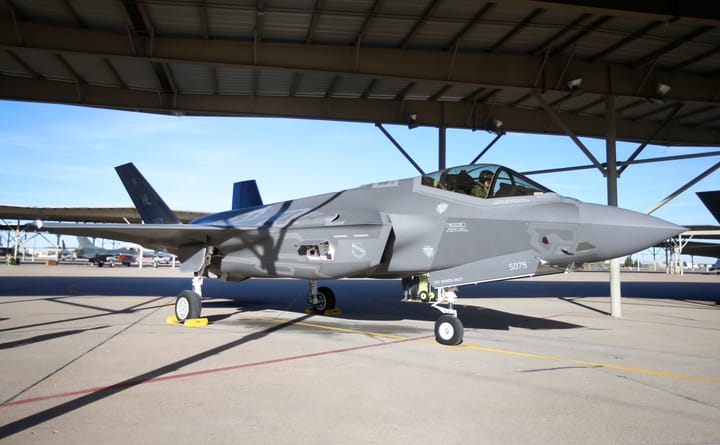The F-35 joint strike fighter, the most expensive weapons program in history, is finally facing tough questions about its future after chronic delays and cost overruns. But over 150 members of Congress are arguing that the dysfunctional aircraft must keep its high level of funding next year, lest the U.S.—which spends more on its military than the next ten countries combined—fall behind in air superiority to “adversaries like China and Russia.”
On April 28, a bipartisan group of 132 House members put out a letter calling on Congress to continue with F-35 production, procurement, and “robust investment,” citing concerns that any spending reduction would lead to a “capability gap that legacy aircraft or new variants thereof cannot fulfill.”
The letter was led by the four co-chairs of the Joint Strike Fighter Caucus: Reps. John Larson (D-Conn.), Marc Veasey (D-Tex.), Michael Turner (R-Ohio), and Chris Stewart (R-Utah). A group of twenty bipartisan senators followed-up with their own pro-F-35 letter released on May 5.
The cost of the F-35 program has nearly doubled to well over $428 billion since its initial estimate of $233 billion in 2001. Annual defense bills by Congress have pushed tens of billions of dollars into the troubled program even as it suffers from a host of technical maladies, bringing the 50-year operating cost of the F-35 to a gigantic $1.727 trillion of public money authorized. Last year, Congress’ defense budget funded 17 more of the planes than the Pentagon requested.
This year, progressives in Congress are renewing calls for President Biden to significantly reduce the military budget, as they called for last summer during the coronavirus pandemic under President Trump.
Even some hawkish Democratic members of Congress with jurisdiction over the Pentagon budget have joined in advocating for reduced spending on the F-35, which in recent months has seen its official support within the Pentagon begin to wane. The powerful House Armed Services Committee Chair Adam Smith (D-Wash.) criticized the jet’s runaway costs, saying, “I want to stop throwing money down that particular rathole” and suggesting the Pentagon find a way to “cut our losses.” Two Democratic subcommittee chairs said last week that they’re wary of adding any more F-35s than the Pentagon requests to the FY2022 defense budget, which is still being developed as part of Biden’s federal budget proposal. The F-35 is one of a handful of projects mentioned in a Feb. 17 memo by Deputy Defense Secretary Kathleen Hicks as being under Pentagon review for potential cuts in acquisitions.
The House letter to the chairs and ranking members of the House Armed Services Committee and the House Defense Appropriations Subcommittee claims, “The F-35 is the only fighter in production that can produce aircraft in the numbers required to recapture our aging fighter force.” It reads, “The F-35 is a great deterrent for the near peer threats of China and Russia; and as such, we urge the committees to support readiness (sustainment), rate (production ramp) and relevance (modernization) for both the airframe (F-35) and the propulsion system (F135).”
The Joint Strike Fighter Caucus is composed of 27 representatives—seven Democrats and 20 Republicans—who led a similar letter last year calling for continued spending on the F-35 program. The caucus was founded in 2011 to prevent F-35 budget cuts by Rep. Kay Granger (R-Tex.), who was the House’s top recipient of cash from Lockheed Martin’s PAC and employees last cycle at nearly $198,000, and then-Rep. Norm Dicks (D-Wash.), whose top career contributors were mostly military contractors, including Lockheed Martin.



